|
mutLBSgeneDB |
| |
| |
| |
| |
| |
| |
|
| Gene summary for NR3C1 |
 Gene summary Gene summary |
| Basic gene Info. | Gene symbol | NR3C1 |
| Gene name | nuclear receptor subfamily 3, group C, member 1 (glucocorticoid receptor) | |
| Synonyms | GCCR|GCR|GCRST|GR|GRL | |
| Cytomap | UCSC genome browser: 5q31.3 | |
| Type of gene | protein-coding | |
| RefGenes | NM_000176.2, NM_001018074.1,NM_001018075.1,NM_001018076.1,NM_001018077.1, NM_001020825.1,NM_001024094.1,NM_001204258.1,NM_001204259.1, NM_001204260.1,NM_001204261.1,NM_001204262.1,NM_001204263.1, NM_001204264.1,NM_001204265.1, | |
| Description | glucocorticoid nuclear receptor variant 1glucocorticoid receptor | |
| Modification date | 20141222 | |
| dbXrefs | MIM : 138040 | |
| HGNC : HGNC | ||
| Ensembl : ENSG00000113580 | ||
| HPRD : 00679 | ||
| Vega : OTTHUMG00000129677 | ||
| Protein | UniProt: P04150 go to UniProt's Cross Reference DB Table | |
| Expression | CleanEX: HS_NR3C1 | |
| BioGPS: 2908 | ||
| Pathway | NCI Pathway Interaction Database: NR3C1 | |
| KEGG: NR3C1 | ||
| REACTOME: NR3C1 | ||
| Pathway Commons: NR3C1 | ||
| Context | iHOP: NR3C1 | |
| ligand binding site mutation search in PubMed: NR3C1 | ||
| UCL Cancer Institute: NR3C1 | ||
| Assigned class in mutLBSgeneDB | A: This gene has a literature evidence and it belongs to targetable_mutLBSgenes. | |
| References showing study about ligand binding site mutation for NR3C1. | 1. Murani, E., Reyer, H., Ponsuksili, S., Fritschka, S., & Wimmers, K. (2012). A substitution in the ligand binding domain of the porcine glucocorticoid receptor affects activity of the adrenal gland. PloS one, 7(9), e45518. 23029068 2. Donner, K. M., Hiltunen, T. P., Jänne, O. A., Sane, T., & Kontula, K. (2013). Generalized glucocorticoid resistance caused by a novel two-nucleotide deletion in the hormone-binding domain of the glucocorticoid receptor gene NR3C1. European Journal of Endocrinology, 168(1), K9-K18. 23076843 3. Nicolaides, N. C., Geer, E. B., Vlachakis, D., Roberts, M. L., Psarra, A. M. G., Moutsatsou, P., ... & Charmandari, E. (2015). A novel mutation of the hGR gene causing Chrousos syndrome. European journal of clinical investigation, 45(8), 782-791. 26031419 | |
 Gene ontology having evidence of Inferred from Direct Assay (IDA) from Entrez Gene ontology having evidence of Inferred from Direct Assay (IDA) from Entrez |
| GO ID | GO Term | PubMed ID | GO:0006355 | regulation of transcription, DNA-templated | 19141540 | GO:0045944 | positive regulation of transcription from RNA polymerase II promoter | 15769988 | GO:0071383 | cellular response to steroid hormone stimulus | 15769988 |
| Top |
| Ligand binding site mutations for NR3C1 |
 Cancer type specific mutLBS sorted by frequency Cancer type specific mutLBS sorted by frequency |
| LBS | AAchange of nsSNV | Cancer type | # samples | L563 | T562M | BRCA | 1 | M604 | M604I | COAD | 1 | K667 | T668P | HNSC | 1 | M604 | M604I | OV | 1 | V443 | V443A | STAD | 1 | L732 | N731T | STAD | 1 | K471 | C473F | STAD | 1 | Q570,G568 | R569W | UCEC | 1 | E751 | E751K | UCEC | 1 |
| cf) Cancer type abbreviation. BLCA: Bladder urothelial carcinoma, BRCA: Breast invasive carcinoma, CESC: Cervical squamous cell carcinoma and endocervical adenocarcinoma, COAD: Colon adenocarcinoma, GBM: Glioblastoma multiforme, LGG: Brain lower grade glioma, HNSC: Head and neck squamous cell carcinoma, KICH: Kidney chromophobe, KIRC: Kidney renal clear cell carcinoma, KIRP: Kidney renal papillary cell carcinoma, LAML: Acute myeloid leukemia, LUAD: Lung adenocarcinoma, LUSC: Lung squamous cell carcinoma, OV: Ovarian serous cystadenocarcinoma, PAAD: Pancreatic adenocarcinoma, PRAD: Prostate adenocarcinoma, SKCM: Skin cutaneous melanoma, STAD: Stomach adenocarcinoma, THCA: Thyroid carcinoma, UCEC: Uterine corpus endometrial carcinoma. |
| Top |
| Protein structure related information for NR3C1 |
 Relative protein structure stability change (ΔΔE) using Mupro 1.1 Relative protein structure stability change (ΔΔE) using Mupro 1.1 Mupro score denotes assessment of the effect of mutations on thermodynamic stability. (ΔΔE<0: mutation decreases stability, ΔΔE>0: mutation increases stability) |
 : nsSNV at non-LBS : nsSNV at non-LBS : nsSNV at LBS : nsSNV at LBS |
 |
 nsSNVs sorted by the relative stability change of protein structure by each mutation nsSNVs sorted by the relative stability change of protein structure by each mutation Blue: mutations of positive stability change. and red : the most recurrent mutation for this gene. |
| LBS | AAchange of nsSNV | Relative stability change | V443 | V443A | -1.2132477 | L732 | N731T | -0.84845558 | K471 | C473F | -0.66889044 | Q570 | R569W | -0.56036191 | G568 | R569W | -0.56036191 | L563 | T562M | -0.54793956 | K667 | T668P | -0.52749314 | E751 | E751K | -0.30421375 | M604 | M604I | -0.29178897 |
| (MuPro1.1: Jianlin Cheng et al., Prediction of Protein Stability Changes for Single-Site Mutations Using Support Vector Machines, PROTEINS: Structure, Function, and Bioinformatics. 2006, 62:1125-1132) |
 Structure image for NR3C1 from PDB Structure image for NR3C1 from PDB |
| Top |
| Differential gene expression and gene-gene network for NR3C1 |
 Differential gene expression between mutated and non-mutated LBS samples in all 16 major cancer types Differential gene expression between mutated and non-mutated LBS samples in all 16 major cancer types |
 Differential co-expressed gene network based on protein-protein interaction data (CePIN) Differential co-expressed gene network based on protein-protein interaction data (CePIN) |
| Top |
| Top |
| Phenotype information for NR3C1 |
 Gene level disease information (DisGeNet) Gene level disease information (DisGeNet) |
| Disease ID | Disease name | # PubMed | Association type |
| umls:C0011581 | Depressive Disorder | 25 | Biomarker |
| umls:C0005586 | Bipolar Disorder | 17 | AlteredExpression, Biomarker, GeneticVariation |
| umls:C0020538 | Hypertension | 14 | Biomarker, GeneticVariation |
| umls:C0036341 | Schizophrenia | 11 | AlteredExpression, Biomarker, GeneticVariation |
| umls:C0028840 | Ocular Hypertension | 2 | Biomarker, GeneticVariation |
| umls:C0014175 | Endometriosis | 2 | Biomarker |
| umls:C0600260 | Lung Diseases, Obstructive | 2 | Biomarker |
| umls:C0033578 | Prostatic Neoplasms | 2 | Biomarker |
| umls:C0033975 | Psychotic Disorders | 2 | Biomarker |
| umls:C0236736 | Cocaine-Related Disorders | 2 | Biomarker |
| umls:C2936403 | 46, XX Disorders of Sex Development | 1 | Biomarker |
| umls:C0020621 | Hypokalemia | 1 | Biomarker |
 Mutation level pathogenic information (ClinVar annotation) Mutation level pathogenic information (ClinVar annotation) |
| Allele ID | AA change | Clinical significance | Origin | Phenotype IDs |
| Top |
| Pharmacological information for NR3C1 |
 Gene expression profile of anticancer drug treated cell-lines (CCLE) Gene expression profile of anticancer drug treated cell-lines (CCLE)Heatmap showing the correlation between gene expression and drug response across all the cell-lines. We chose the top 20 among 138 drugs.We used Pearson's correlation coefficient. |
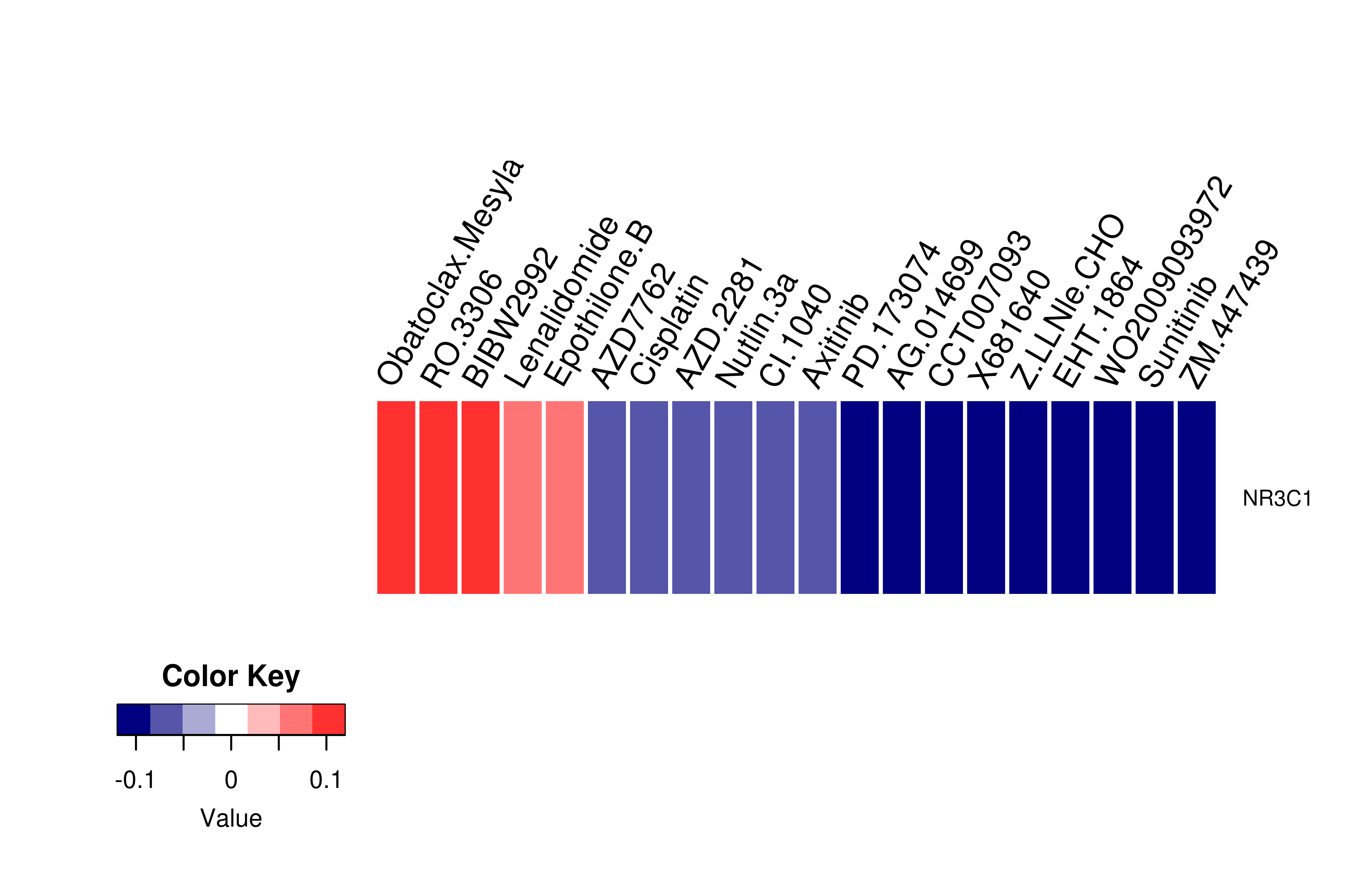 |
 Gene-centered drug-gene interaction network Gene-centered drug-gene interaction network |
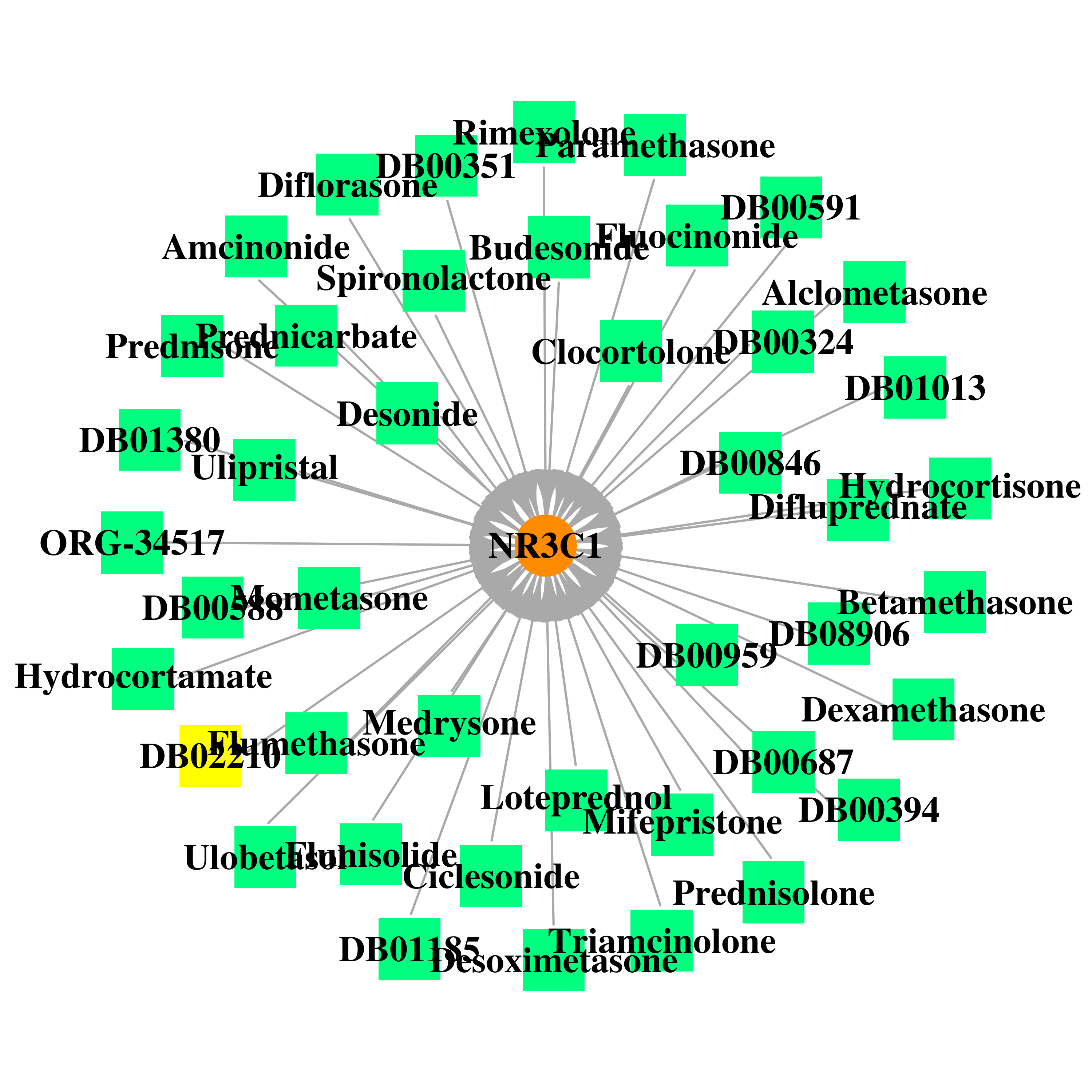 |
 Drug information targeting mutLBSgene (Approved drugs only) Drug information targeting mutLBSgene (Approved drugs only) |
| Drug status | DrugBank ID | Name | Type | Drug structure |
| Approved|investigational | DB00180 | Flunisolide | Small molecule | 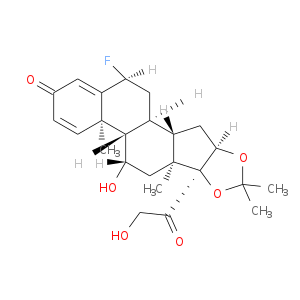 |
| Approved | DB00223 | Diflorasone | Small molecule |  |
| Approved | DB00240 | Alclometasone | Small molecule |  |
| Approved | DB00253 | Medrysone | Small molecule | 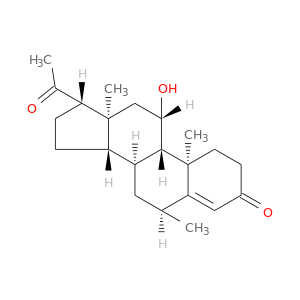 |
| Approved | DB00288 | Amcinonide | Small molecule |  |
| Approved | DB00324 | Fluorometholone | Small molecule |  |
| Approved|vet_approved | DB00351 | Megestrol acetate | Small molecule | 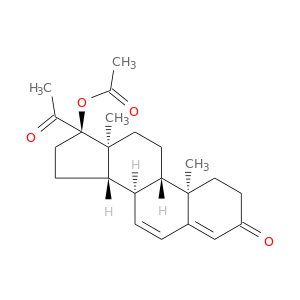 |
| Approved|investigational | DB00394 | Beclomethasone dipropionate | Small molecule |  |
| Approved | DB00421 | Spironolactone | Small molecule | 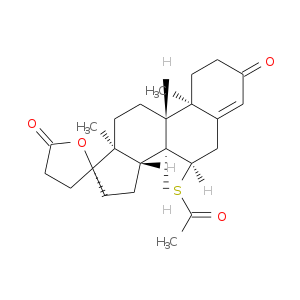 |
| Approved|vet_approved | DB00443 | Betamethasone | Small molecule | 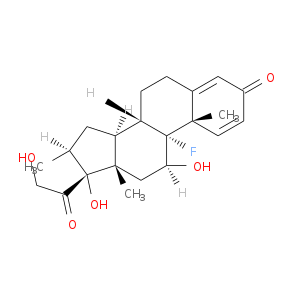 |
| Approved | DB00547 | Desoximetasone | Small molecule |  |
| Approved | DB00588 | Fluticasone Propionate | Small molecule |  |
| Approved|investigational|vet_approved | DB00591 | Fluocinolone Acetonide | Small molecule |  |
| Approved | DB00596 | Ulobetasol | Small molecule |  |
| Approved|vet_approved | DB00620 | Triamcinolone | Small molecule |  |
| Approved|vet_approved | DB00635 | Prednisone | Small molecule |  |
| Approved|vet_approved | DB00663 | Flumethasone | Small molecule |  |
| Approved | DB00687 | Fludrocortisone | Small molecule |  |
| Approved|vet_approved | DB00741 | Hydrocortisone | Small molecule | 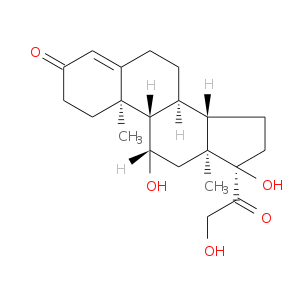 |
| Approved|vet_approved | DB00764 | Mometasone | Small molecule | 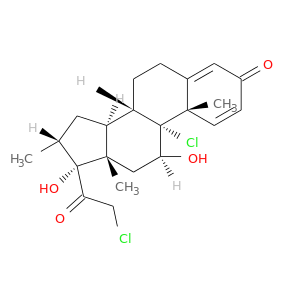 |
| Approved | DB00769 | Hydrocortamate | Small molecule |  |
| Approved|investigational | DB00834 | Mifepristone | Small molecule | 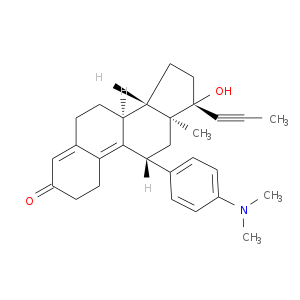 |
| Approved | DB00838 | Clocortolone | Small molecule |  |
| Approved | DB00846 | Flurandrenolide | Small molecule |  |
| Approved|vet_approved | DB00860 | Prednisolone | Small molecule | 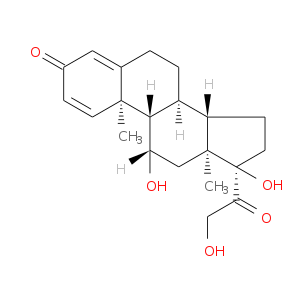 |
| Approved | DB00873 | Loteprednol | Small molecule |  |
| Approved | DB00896 | Rimexolone | Small molecule | 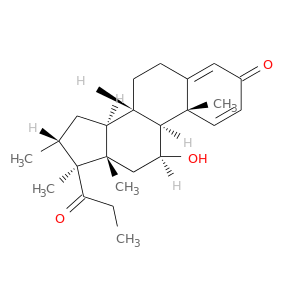 |
| Approved|vet_approved | DB00959 | Methylprednisolone | Small molecule |  |
| Approved | DB01013 | Clobetasol propionate | Small molecule | 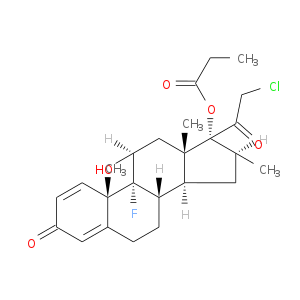 |
| Approved|investigational | DB01047 | Fluocinonide | Small molecule |  |
| Approved | DB01130 | Prednicarbate | Small molecule | 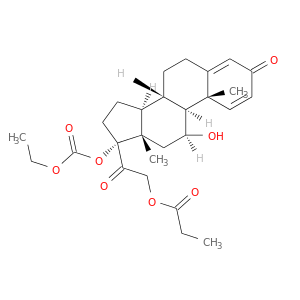 |
| Approved|illicit | DB01185 | Fluoxymesterone | Small molecule |  |
| Approved | DB01222 | Budesonide | Small molecule | 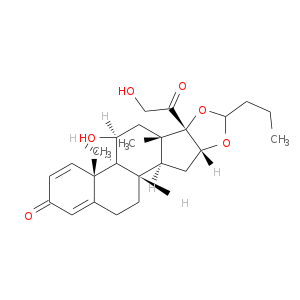 |
| Approved|investigational|vet_approved | DB01234 | Dexamethasone | Small molecule | 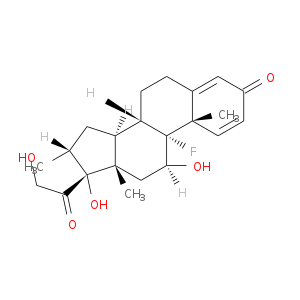 |
| Approved|investigational | DB01260 | Desonide | Small molecule | 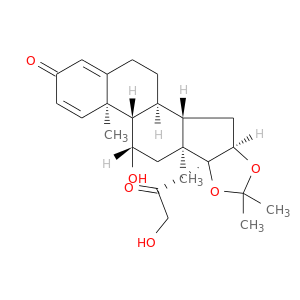 |
| Approved | DB01380 | Cortisone acetate | Small molecule |  |
| Approved | DB01384 | Paramethasone | Small molecule |  |
| Approved|investigational | DB01410 | Ciclesonide | Small molecule | 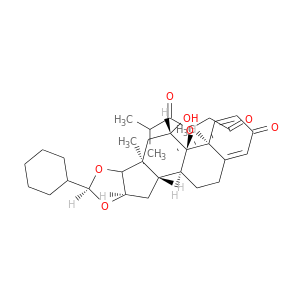 |
| Experimental | DB02210 | Hexane-1,6-Diol | Small molecule | 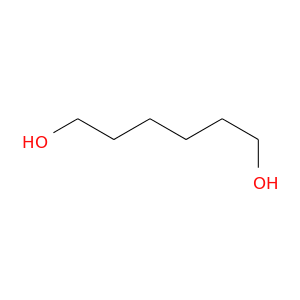 |
| Investigational | DB05423 | ORG-34517 | Small molecule |  |
| Approved | DB06781 | Difluprednate | Small molecule |  |
| Approved | DB08867 | Ulipristal | Small molecule |  |
| Approved | DB08906 | Fluticasone furoate | Small molecule |  |
 Gene-centered ligand-gene interaction network Gene-centered ligand-gene interaction network |
 |
 Ligands binding to mutated ligand binding site of NR3C1 go to BioLip Ligands binding to mutated ligand binding site of NR3C1 go to BioLip |
| Ligand ID | Ligand short name | Ligand long name | PDB ID | PDB name | mutLBS | III | Peptide ligand (PRO,VAL,SER,PRO,LYS,LYS,LYS,GLU,ASN,ALA,LEU,LEU,ARG,TYR,LEU,LEU,ASP,LYS,ASP,ASP,THR) | 1m2z | D | E751 | III | Peptide ligand (GLN,LYS,SER,LEU,LEU,GLN,GLN,LEU,LEU,THR,GLU) | 3bqd | A | E751 | III | Peptide ligand (ALA,LEU,LEU,ARG,TYR,LEU,LEU,ASP,LYS) | 3k23 | A | E751 | III | Peptide ligand (ASN,ALA,LEU,LEU,ARG,TYR,LEU,LEU,ASP,LYS) | 3k23 | B | E751 | III | Peptide ligand (GLU,ASN,ALA,LEU,LEU,ARG,TYR,LEU,LEU,ASP) | 3k23 | C | E751 | III | Peptide ligand (GLU,ASN,ALA,LEU,LEU,ARG,TYR,LEU,LEU,ASP,LYS,ASP,ASP) | 4csj | A | E751 | III | Peptide ligand (GLU,ASN,ALA,LEU,LEU,ARG,TYR,LEU,LEU,ASP,LYS,ASP,ASP) | 4udc | A | E751 | III | Peptide ligand (GLU,ASN,ALA,LEU,LEU,ARG,TYR,LEU,LEU,ASP,LYS,ASP,ASP) | 4udd | A | E751 | NUC | Nucleic Acids | 4hn5 | B | K471 | NUC | Nucleic Acids | 4hn6 | B | K471 | NUC | Nucleic Acids | 5cc1 | A | K471 | NUC | Nucleic Acids | 5cc1 | W | K471 | JZR | HEXYL BETA-D-GLUCOPYRANOSIDE | 3k22 | A | L563 | JZR | HEXYL BETA-D-GLUCOPYRANOSIDE | 3k22 | B | L563 | 486 | MIFEPRISTONE | 3h52 | B | L563 G568 Q570 M604 L732 | 486 | MIFEPRISTONE | 3h52 | A | L563 Q570 L732 | DEX | DEXAMETHASONE | 1m2z | A | L563 Q570 M604 | DEX | DEXAMETHASONE | 1m2z | D | L563 Q570 M604 | DEX | DEXAMETHASONE | 1p93 | A | L563 Q570 M604 | DEX | DEXAMETHASONE | 1p93 | B | L563 Q570 M604 | DEX | DEXAMETHASONE | 1p93 | D | L563 Q570 M604 | 866 | 5-AMINO-N-[(2S)-2-({[(2,6-DICHLOROPHENYL)CARBONYL](ETHYL)AMINO}METHYL)-3,3,3-TRIFLUORO-2-HYDROXYPROPYL]-1-(4-FLUOROPHENYL)-1H-PYRAZOLE-4-CARBOXAMIDE | 3e7c | A | L563 Q570 M604 | 866 | 5-AMINO-N-[(2S)-2-({[(2,6-DICHLOROPHENYL)CARBONYL](ETHYL)AMINO}METHYL)-3,3,3-TRIFLUORO-2-HYDROXYPROPYL]-1-(4-FLUOROPHENYL)-1H-PYRAZOLE-4-CARBOXAMIDE | 3e7c | B | L563 Q570 M604 | 486 | MIFEPRISTONE | 3h52 | C | L563 Q570 M604 | JZS | N-[(1R)-2-AMINO-1-METHYL-2-OXOETHYL]-3-(6-METHYL-4-{[3,3,3-TRIFLUORO-2-HYDROXY-2-(TRIFLUOROMETHYL)PROPYL]AMINO}-1H-INDAZOL-1-YL)BENZAMIDE | 3k22 | A | L563 Q570 M604 | JZS | N-[(1R)-2-AMINO-1-METHYL-2-OXOETHYL]-3-(6-METHYL-4-{[3,3,3-TRIFLUORO-2-HYDROXY-2-(TRIFLUOROMETHYL)PROPYL]AMINO}-1H-INDAZOL-1-YL)BENZAMIDE | 3k22 | B | L563 Q570 M604 | JZN | 1-{[3-(4-{[(2R)-4-(5-FLUORO-2-METHOXYPHENYL)-2-HYDROXY-4-METHYL-2-(TRIFLUOROMETHYL)PENTYL]AMINO}-6-METHYL-1H-INDAZOL-1-YL)PHENYL]CARBONYL}-D-PROLINAMIDE | 3k23 | A | L563 Q570 M604 | MOF | MOMETASONE FUROATE | 4p6w | A | L563 Q570 M604 | HCY | (11ALPHA,14BETA)-11,17,21-TRIHYDROXYPREGN-4-ENE-3,20-DIONE | 4p6x | A | L563 Q570 M604 | HCY | (11ALPHA,14BETA)-11,17,21-TRIHYDROXYPREGN-4-ENE-3,20-DIONE | 4p6x | C | L563 Q570 M604 | HCY | (11ALPHA,14BETA)-11,17,21-TRIHYDROXYPREGN-4-ENE-3,20-DIONE | 4p6x | E | L563 Q570 M604 | HCY | (11ALPHA,14BETA)-11,17,21-TRIHYDROXYPREGN-4-ENE-3,20-DIONE | 4p6x | G | L563 Q570 M604 | HCY | (11ALPHA,14BETA)-11,17,21-TRIHYDROXYPREGN-4-ENE-3,20-DIONE | 4p6x | I | L563 Q570 M604 | HCY | (11ALPHA,14BETA)-11,17,21-TRIHYDROXYPREGN-4-ENE-3,20-DIONE | 4p6x | K | L563 Q570 M604 | DEX | DEXAMETHASONE | 4udc | A | L563 Q570 M604 | CV7 | DESISOBUYTYRYL CICLESONIDE | 4udd | A | L563 Q570 M604 | JZN | 1-{[3-(4-{[(2R)-4-(5-FLUORO-2-METHOXYPHENYL)-2-HYDROXY-4-METHYL-2-(TRIFLUOROMETHYL)PENTYL]AMINO}-6-METHYL-1H-INDAZOL-1-YL)PHENYL]CARBONYL}-D-PROLINAMIDE | 3k23 | B | L563 Q570 M604 K667 L732 | 486 | MIFEPRISTONE | 1nhz | A | L563 Q570 M604 L732 | DEX | DEXAMETHASONE | 1p93 | C | L563 Q570 M604 L732 | DAY | DEACYLCORTIVAZOL | 3bqd | A | L563 Q570 M604 L732 | GW6 | VERAMYST | 3cld | A | L563 Q570 M604 L732 | GW6 | VERAMYST | 3cld | B | L563 Q570 M604 L732 | 486 | MIFEPRISTONE | 3h52 | D | L563 Q570 M604 L732 | JZN | 1-{[3-(4-{[(2R)-4-(5-FLUORO-2-METHOXYPHENYL)-2-HYDROXY-4-METHYL-2-(TRIFLUOROMETHYL)PENTYL]AMINO}-6-METHYL-1H-INDAZOL-1-YL)PHENYL]CARBONYL}-D-PROLINAMIDE | 3k23 | C | L563 Q570 M604 L732 | LSJ | N-{3-[(1Z)-1-(10-METHOXYDIBENZO[B,E]OXEPIN-11(6H)- YLIDENE)PROPYL]PHENYL}METHANESULFONAMIDE | 4lsj | A | L563 Q570 M604 L732 | NN7 | N-[(2S)-1-[[1-(4-FLUOROPHENYL)INDAZOL-4-YL] AMINO]PROPAN-2-YL]-2,4,6-TRIMETHYL- BENZENESULFONAMIDE | 4csj | A | L563 Q570 M604 L732 | NUC | Nucleic Acids | 4hn5 | A | V443 K471 | NUC | Nucleic Acids | 4hn6 | A | V443 K471 |
| Top |
| Conservation information for LBS of NR3C1 |
 Multiple alignments for P04150 in multiple species Multiple alignments for P04150 in multiple species |
| LBS | AA sequence | # species | Species |
 |
Copyright © 2016-Present - The University of Texas Health Science Center at Houston |
